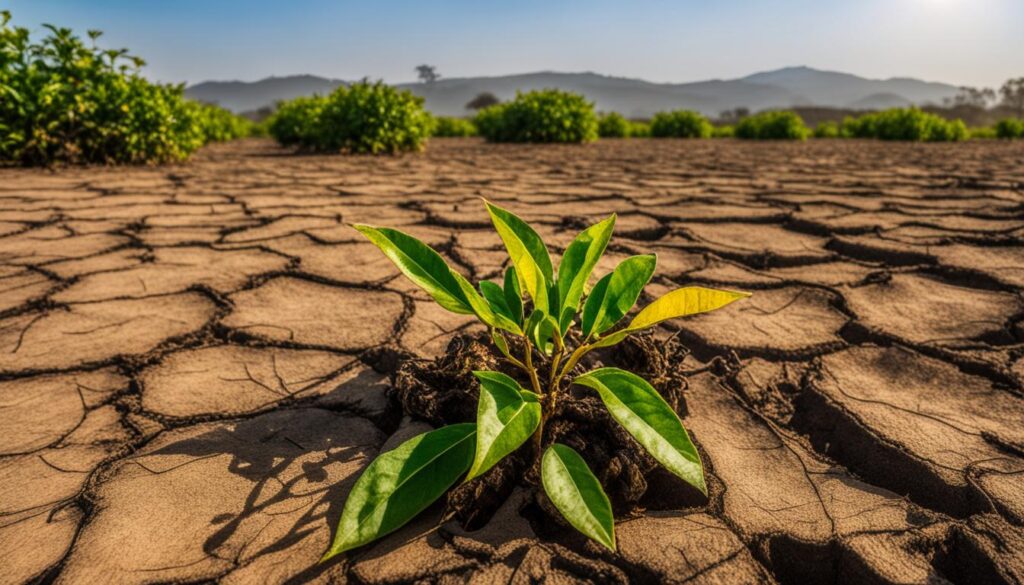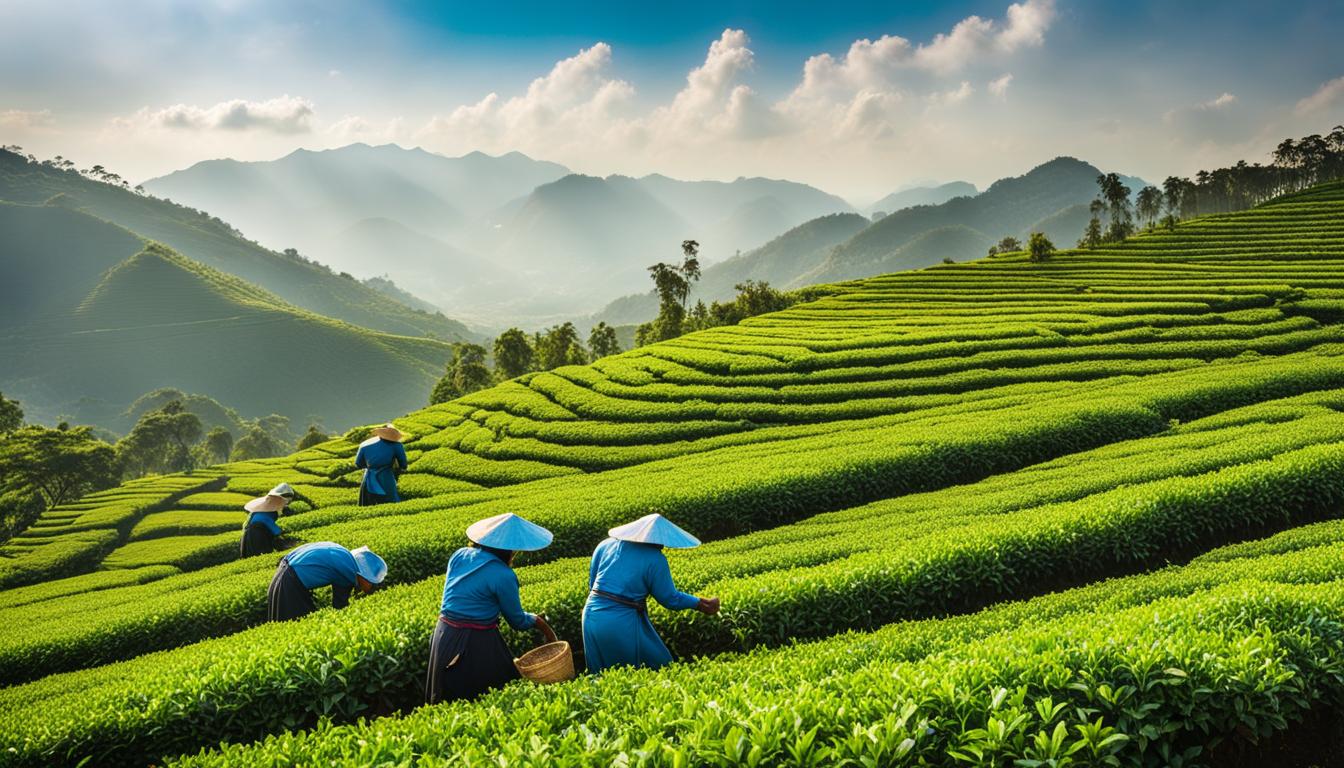We all know that tea is more than just a beverage. It’s a cultural icon, a soothing elixir, and a global sensation. But did you know that tea production has a significant economic impact in countries like China, India, and Sri Lanka? Let’s dive into the fascinating world of tea economics and discover why it matters.
Key Takeaways:
- Tea consumption is on the rise in China, India, and other emerging economies, driven by higher incomes and the popularity of specialty teas.
- China is projected to reach Kenya’s level as the largest black tea exporter, with green tea production set to more than double by 2027.
- Climate change poses a threat to tea production, impacting yields, quality, and prices.
- The promotion of health benefits has contributed to the increased demand for tea, especially in the United States.
- Tea production plays a vital role in rural development, poverty reduction, and food security in developing countries.
Global Tea Consumption and Production Growth
Tea consumption and production on a global scale are expected to witness significant growth in the coming years. This growth is driven by the increasing demand for tea in developing and emerging countries, particularly in China and India. The rise in incomes and the growing popularity of specialty teas have contributed to the rapid expansion of tea consumption in these regions.
According to projections, black tea production is estimated to increase by 2.2% annually, reaching 4.4 million tonnes by 2027. Similarly, green tea production is forecasted to grow at a rate of 7.5% per year, reaching 3.6 million tonnes by 2027. This upward trend in tea production not only meets the rising demand but also creates new income opportunities for rural communities in tea-producing countries. It plays a crucial role in enhancing food security and promoting economic development.
In light of these growth prospects, it is evident that the tea industry holds immense potential for the future. However, it is essential to address the challenges posed by climate change, as it jeopardizes tea production by impacting yields, quality, and prices. The integration of climate change considerations into national tea development strategies is crucial to ensure the sustainability of the industry.
Impact of Climate Change on Tea Production
Climate change poses a significant threat to tea production, impacting yields, quality, and prices. Changes in temperature and rainfall patterns disrupt the delicate balance needed for optimal tea cultivation. As a result, tea-producing countries are facing lower incomes, jeopardizing rural livelihoods and calling for urgent adaptation measures.
The vulnerability of tea production to climate change highlights the need for tea-producing countries to integrate climate change challenges into their national tea development strategies. By doing so, they can mitigate the adverse effects of climate change and safeguard one of their most important industries.
“The impact of climate change on tea production is undeniable. Rising temperatures and unpredictable weather patterns are disrupting the traditional tea-growing regions, affecting both small-scale farmers and large tea plantations. It’s crucial for us to develop and implement strategies that not only adapt to climate change but also reduce greenhouse gas emissions from tea production and processing.”
– Dr. Sarah Green, Climate Scientist
In addition to adaptation strategies, there is a growing recognition of the need to reduce carbon emissions from tea production and processing. Several tea-producing countries have begun implementing sustainable practices, such as renewable energy sources and improved waste management systems, to minimize their carbon footprint.
Addressing the impact of climate change on tea production requires a concerted effort from all stakeholders. Governments, tea industry organizations, and consumers must work together to support sustainable tea production practices and mitigate the effects of climate change on one of the world’s most beloved beverages.

Growing Demand for Specialty Tea and Health Benefits
As tea consumption continues to soar in China and India, there is a noticeable trend towards specialty teas and an increased awareness of the health benefits associated with tea consumption. Young urban consumers in these countries, particularly the millennial generation, are the driving force behind this growing demand. They are willing to pay a premium for high-quality teas and are increasingly interested in the origin, sustainability, and unique flavors of these specialty products.
The promotion of health benefits has also played a significant role in the surge of tea consumption. The recognition of tea’s anti-inflammatory, antioxidant, and weight loss properties has captured the attention of health-conscious individuals, leading to an increase in tea consumption worldwide. The demand for teas with specific health benefits has diversified the market, with a wide range of specialty teas now available to cater to individual preferences and needs.
“Tea is not just a beverage; it’s a lifestyle. The rise of specialty teas and the emphasis on health benefits have transformed the way we perceive and consume tea. It’s no longer just a warm drink; it’s a holistic experience that offers unique flavors and wellness advantages.”
Tea Consumption Trends
The surge in specialty tea consumption is evident in both China and India, where young consumers seek out unique tea experiences. According to industry reports, specialty tea sales in China have seen double-digit growth in recent years, with consumers increasingly exploring premium teas like oolong, white tea, and pu-erh. Similarly, in India, there has been a notable shift towards specialty teas, with consumers showing a growing preference for high-quality Darjeeling, Assam, and Nilgiri teas.
The rise of specialty teas is not limited to China and India alone. In the United States and other Western markets, there has been a significant increase in the consumption of specialty and artisanal teas. Health-conscious consumers are actively seeking out teas with specific health benefits, such as immune-boosting properties or stress relief capabilities. This growing demand for specialty teas has paved the way for innovative tea blends, unique flavor profiles, and a vibrant tea culture that extends beyond traditional black and green teas.
Opportunities for Tea Industry
For tea producers and retailers, the growing demand for specialty tea and health benefits opens up a world of opportunities. By offering a diverse range of specialty teas, producers can tap into the preferences of health-conscious consumers and cater to their individual tastes. They can also leverage the uniqueness of their tea products by highlighting their origin, flavor profiles, and sustainable production practices.
Furthermore, the emphasis on health benefits provides an avenue for tea producers to engage with consumers through educational campaigns and marketing initiatives. By highlighting tea’s medicinal properties and its positive impact on overall well-being, producers can create a deeper connection with consumers and drive further demand for their specialty products.
As the popularity of specialty teas continues to rise, it is essential for tea producers and retailers to stay ahead of the curve, constantly innovating and exploring new flavors, blends, and health benefits. By doing so, they can capture a larger share of the growing specialty tea market and meet the evolving demands of tea enthusiasts worldwide.
Table 4: Tea Consumption Trends in Key Markets
| Country | Specialty Tea Consumption Growth | Health Benefits Emphasized |
|---|---|---|
| China | Double-digit growth | Anti-inflammatory, antioxidant properties |
| India | Rising preference for specialty teas | Promotion of Darjeeling, Assam, and Nilgiri teas |
| United States | Significant increase in artisanal and specialty tea consumption | Focus on immune-boosting and stress relief benefits |
| Other Western Markets | Growing demand for diverse tea blends and unique flavor profiles | Exploration of various health benefits |
Note: The table provides a snapshot of tea consumption trends in key markets. It showcases the growth of specialty tea consumption and the specific health benefits emphasized in each market. The data highlights the global shift towards specialty teas and the increasing focus on health and wellness aspects of tea consumption.
Economic Impact of Tea Production in Sri Lanka
Sri Lanka is a key player in the global tea market, with its tea production having a significant economic impact on the country. Annually, Sri Lanka produces approximately 300 million kg of tea and exports around 97-98% of its output. In fact, Sri Lanka accounts for around 50% of the total global trade of orthodox tea. This demonstrates the crucial role that tea production plays in the economic development of the country.
The economic crisis faced by Sri Lanka has led to concerns about a potential decline in tea production and shipments. However, this situation presents an opportunity for Indian exporters to step in and fill the gap left by Sri Lankan tea. As a result, South Indian exporters have already seen benefits with the shortage of Sri Lankan tea leading to higher prices.
To maximize this opportunity, Indian exporters would need to devise their own strategies to expand their exports. It is essential for them to differentiate their tea from Sri Lankan tea and leverage the increased demand for tea in the global market. The promotion of the unique qualities and flavors of Indian tea could help Indian exporters capture a larger share of the market.
“The decline in Sri Lanka’s tea production provides an opportunity for Indian exporters to meet global demand. Indian exporters can benefit from the shortage of Sri Lankan tea and increased prices, especially if trade with Russia improves.” – Tea Industry Expert
Comparison of Tea Production in Sri Lanka and India
| Sri Lanka | India | |
|---|---|---|
| Annual tea production (in million kg) | 300 | 1,350 |
| Percentage of tea exported | 97-98% | 19-21% |
| Global market share | 50% (orthodox tea) | Approximately 23% |
The table above showcases the differences in tea production and export between Sri Lanka and India. While Sri Lanka has a higher percentage of its tea production exported, India has a larger annual tea production volume and a significant global market share. With the decline in Sri Lanka’s tea production, Indian exporters can leverage their higher production capacity to meet the increasing global demand for tea.
In conclusion, the economic impact of tea production in Sri Lanka is substantial, contributing to the country’s GDP and providing income opportunities. The decline in tea production presents an opportunity for Indian exporters to fill the gap and expand their exports. By devising effective strategies and promoting the unique qualities of Indian tea, exporters can capitalize on the growing demand for tea in the global market.

Opportunities for Indian Tea Exporters
In light of the decline in tea production in Sri Lanka, Indian exporters have a unique opportunity to meet the global demand for tea. With the shortage of Sri Lankan tea and the subsequent increase in prices, Indian exporters can capitalize on this situation and expand their market presence. One potential market for Indian tea is Russia, where Sri Lankan tea is popular. By improving trade relations and increasing shipments, Indian exporters can fill the gap left by the decline in Sri Lankan tea production.
To differentiate their tea from Sri Lankan tea, Indian exporters should emphasize the unique qualities and flavors of their products. By highlighting the diverse range of teas available from various regions in India, exporters can attract new customers who are looking for different tastes and experiences. Additionally, exporters should focus on sustainable and environmentally friendly practices, as these factors are increasingly important to consumers.
“With the shortage of Sri Lankan tea, Indian exporters have a valuable opportunity to expand their market presence and satisfy global demand.”
Furthermore, Indian exporters may need to devise their own strategies to increase exports and secure long-term growth. This could include exploring new markets, improving distribution channels, or enhancing packaging and branding to appeal to international buyers. By positioning themselves as reliable and high-quality suppliers, Indian exporters can establish strong relationships with buyers and gain a competitive edge.
Key Opportunities for Indian Tea Exporters:
- Fill the gap left by the decline in Sri Lankan tea production
- Target the Russian market by emphasizing the popularity of tea in Russia
- Differentiate Indian tea by highlighting unique flavors and qualities
- Focus on sustainability and environmentally friendly practices
- Devise strategies to increase exports and secure long-term growth
In conclusion, the shortage of Sri Lankan tea presents exciting opportunities for Indian exporters to expand their presence in the global tea market. By leveraging their unique offerings and focusing on key markets, Indian exporters can meet the increasing demand for tea and establish themselves as leaders in the industry.
Conclusion
Tea production plays a significant role in the economic development of Asia. The industry’s importance can be seen in countries like China, India, and Sri Lanka, where tea provides income opportunities, contributes to GDP, and supports rural development. The economic impact of tea goes beyond the industry itself, benefiting communities and enhancing food security.
However, the tea industry faces challenges from climate change, which impacts yields, quality, and prices. As temperatures and rainfall patterns fluctuate, tea production must adapt and integrate climate change challenges into national strategies. It is also crucial to reduce carbon emissions from tea production and processing, mitigating the industry’s contribution to climate change.
Despite these challenges, the tea industry presents opportunities for growth. The increasing demand for specialty teas and the promotion of health benefits have created new avenues for expansion. Young urban consumers in China and India, in particular, are driving this growth by seeking premium teas with unique qualities and sustainable sourcing.
Furthermore, the decline in tea production in Sri Lanka has created an opportunity for Indian exporters. With the shortage of Sri Lankan tea, Indian exporters can meet the global demand and potentially benefit from increased prices. However, it is crucial for Indian exporters to differentiate their tea from Sri Lankan tea and devise their own strategies to increase exports and capitalize on this opportunity.
FAQ
What factors are driving the increase in tea consumption in China, India, and other emerging economies?
Higher incomes and the popularity of specialty teas are the main factors driving the increase in tea consumption in these countries.
How does climate change affect tea production?
Climate change poses a threat to tea production by impacting yields, quality, and prices due to changes in growing conditions such as temperature and rainfall patterns.
What are the health benefits associated with tea consumption?
Tea consumption is promoted for its health benefits, such as anti-inflammatory, antioxidant, and weight-loss effects.
What is the economic impact of tea production in Sri Lanka?
Sri Lanka’s tea production contributes significantly to its GDP and provides income opportunities. The country is a major player in the global tea market.
How can Indian tea exporters benefit from the decline in Sri Lankan tea production?
The shortage of Sri Lankan tea has created higher prices, providing Indian exporters with an opportunity to fill the gap and expand their exports.
What role does tea production play in rural development and food security?
Tea production plays a significant role in rural development, poverty reduction, and food security in developing countries like China, India, and Sri Lanka.
Source Links
- https://www.fao.org/3/i4482e/i4482e.pdf
- https://www.fao.org/newsroom/detail/Global-tea-consumption-and-production-driven-by-robust-demand-in-China-and-India/en
- https://economictimes.com/small-biz/trade/exports/insights/sri-lankan-economic-crisis-may-provide-opportunities-for-indian-tea-exporters-experts/articleshow/90655170.cms





